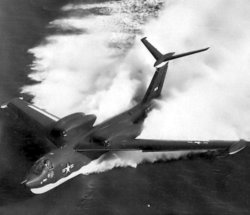P6M SeaMaster
|
|
The Martin P6M SeaMaster, built by the Glenn L. Martin Company, was a 1950s strategic bomber flying boat for the United States Navy that almost entered service; production aircraft had been built and Navy crews were undergoing operational conversion, with a service entry about six months off, when the program was cancelled on August 21, 1959. Envisaged as a way to give the US Navy a strategic nuclear force, the SeaMaster was eclipsed by the much more credible threat of the Polaris submarine launched ballistic missile.
In the immediate postwar defense climate, the US Air Force's Strategic Air Command was the linchpin of the United States' security as the sole means of delivery of the nation's nuclear arsenal. The US Navy saw its strategic role being eclipsed by the Air Force and knew both its prestige and budgets were at stake. Its first attempt, the USS United States, a large 'super carrier' to launch Navy strategic bombers from, having been a victim of budget cuts, the Navy chose instead to create a "Seaplane Striking Force" useful for both nuclear and conventional warfare, including reconnaissance and minelaying. Groups of these planes, supported by seaplane tenders or even special submarines, could be located closer to the enemy, and as mobile targets would be harder to neutralize.
The requirement, issued in April 1951, was for a seaplane able to carry 30,000 lb (13,600 kg) of bombs to a target 1,500 miles (2,400 km) away from its aquatic base. The aircraft had to be capable of a low altitude attack run at Mach 0.9 (1,103 km/h), which required an extremely capable aircraft. Both Convair and Martin submitted proposals, and the Martin one was chosen as more promising. An order for two prototypes was issued, which was projected to lead to six pre-production aircraft and a projected twenty-four production planes.
Originally the plane was to have a Curtis-Wright turbo-ramjet engine, but this ran into problems and a more conventional Allison J71-A-4 turbojet was employed, fitted in pairs in overwing pods to keep the spray out of the intakes. Wings swept at 40° were used; they displayed a notable anhedral (downward slope to the tip) and were designed with tip tanks that doubled as floats on the water. Many features of Martin's XB-51 bomber prototype were used, including an all-flying "T" tail and a rotating bomb-bay -- pneumatically sealed against seawater, here.
First flights of the XP6M-1 in 1955 showed that the engines were mounted too close to the fuselage and scorched it when afterburners were used, leading to pointing the engines a little outward in subsequent aircraft. Flight testing was initially successful but on December 17, 1955 was marred by accident, a control system fault destroying the first prototype with the loss of all four lives aboard. Almost a year later, on November 9, 1956, the second prototype was also destroyed, thanks to an error in the tail control system design, but this time the crew ejected safely.
The first pre-production YP6M-1 was completed about a year later, with testing resuming in January 1958. Five more were built in 1958. These aircraft were fitted with test versions of the full combat equipment suite and were used for bombing, minelaying and reconnaissance evaluations.
This program proving successful, the first production P6M-2 was rolled out in early 1959. Changes included new, more powerful J75 engines, an inflight refuelling probe, improved avionics and a canopy with better visibility. A buddy refuelling drogue kit had also been developed to fit in the bomb bay. Three had been built by summer 1959 and Navy crews were moving them through operational conversion when the program was abruptly cancelled in August of that year.
The P6M-2 was certainly an impressive aircraft; its Mach 0.9 (1,103 km/h) performance 'on the deck' could be equalled by few aircraft of the time and not too many more now. A USAF B-52 can only reach Mach 0.55 (674 km/h) at low altitude. The planes were built incredibly tough, with the aircraft skin at the wing roots over an inch (25 mm) thick.
Although the technology was up-to-date, the requirement was outdated; in the age of the ICBM and SLBM, the manned bomber was an expensive, unreliable way to deliver nuclear weapons. The P6M program had already cost $400 million (about $2.5 billion in 2004 dollars) and could not be justified without the strategic mission.
All of the aircraft were scrapped. Some tail sections were retained for testing, and one of these is now in the Glenn L. Martin museum, along with some wingtip floats re-used by a Martin employee to build a catamaran.
Martin tried unsuccessfully to market the technology in the civilian market but there were no takers, and the company soon abandoned the aircraft business entirely to focus on missiles and electronics. The P6M was Martin's final aircraft design to see metal.
| Related content | |
|---|---|
| Related development | P5M Marlin |
| Similar aircraft | Beriev Be-10 |
| Designation series | PM - P2M - P3M - P4M - P5M - P6M - P7M |
| Related lists | List of military aircraft of the United States - List of flying boats and seaplanes |
|
Lists of Aircraft | Aircraft manufacturers | Aircraft engines | Aircraft engine manufacturers Airports | Airlines | Air forces | Aircraft weapons | Missiles | Timeline of aviation |

